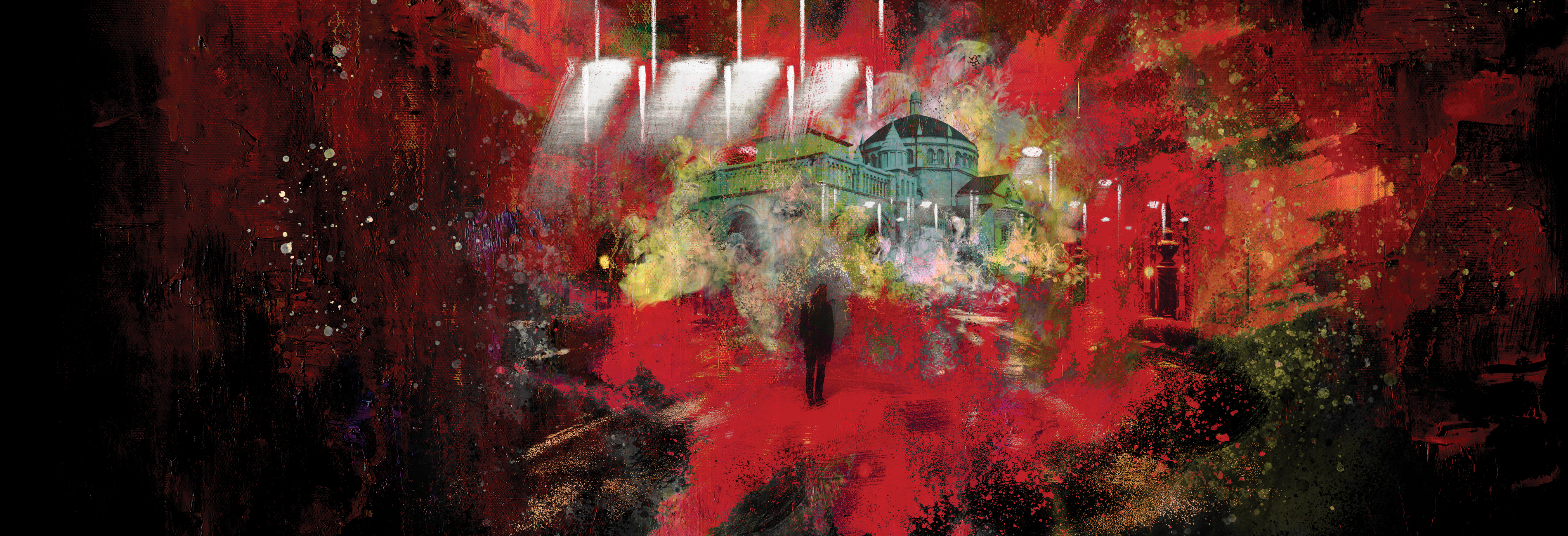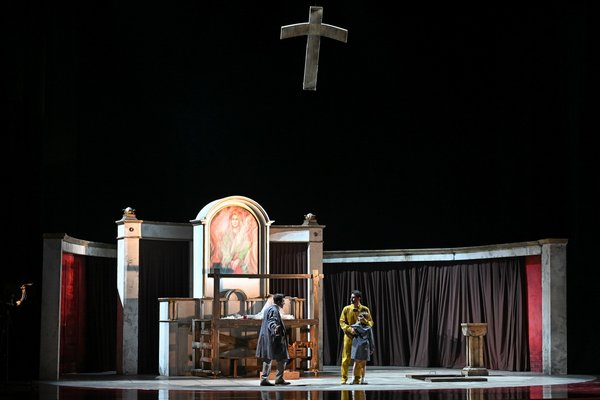
TOSCA
In Brief
Opera in three acts, three parts, in Italian, with Hungarian, English, and Italian surtitles
The point of Puccini's Tosca is not that it is set in Rome or in the summer of 1800. The dilemmas, emotions, and shocking plot twists make the piece interesting. Equally important to the story is the frame of a totalitarian regime where the chief of police can do as he pleases: he can capture without warrant, unlawfully torture, imprison without trial, and execute without verdict whomever he wants. The opera showcases the bravery, faithfulness, and inevitable tragedy of the singer Tosca and the painter Mario, for which a setting of Budapest in the 50's, when the Opera House itself became a spot of events of dictatorship and cult of personality, is a perfect analogy. This new production of Tosca does not have any obvious symbols or historic figures, but the suffocating air of this dark era is palpable: innocent and harmless artists had to die just like they had in the world of the fictional Baron Scarpia.
Source of some pictures used in this production: Fortepan
Source of some pictures used in this production: Fortepan
Synopsis
Act I
Angelotti, a political refugee has escaped from prison and seeks refuge in the church where his sister, Attavanti has deposited female clothes, a veil, and a fan for his flight. Angelotti conceals himself when the Sacristan arrives looking for the painter Cavaradossi. The Sacristan is outraged by the altar painting on which the painter is working: the figure of St Magdalena resembles the features of a beautiful unknown woman (Attavanti) who has often been observed at prayer in the church recently. Observing the painting, Cavaradossi thinks of two faces: the blonde stranger who has, unknowingly, served as a model for him, and the one his heart belongs to, the brown-haired, black-eyed Tosca. Angelotti comes out from his hiding place. Cavaradossi is prepared to assist his old friend, the fugitive politician, but their conversation is interrupted by the voice of Tosca who has come unexpectedly and uninvited to see her lover. Angelotti returns to his hiding place. Tosca’s jealousy is aroused, perhaps not without any reason, when Cavaradossi does not open the church door at once. Her jealousy gets stronger when she recognizes Attavanti’s features in Cavaradossi's painting. Cavaradossi succeeds in pacifying her, and they confess their love for each other. When Tosca leaves, the painter offers to hide the fugitive in a well in the garden of his house on the confines of the city. A cannon is fired: whether the escape of the fugitive has been discovered, or a great celebration is announced remains to be seen. In any case, the painter and the fugitive take their leave together.
Choirboys flock into the church preparing for a joyful Te Deum exulting over the news of military victory. A celebratory feast is planned for the evening with Tosca singing a new cantata. Scarpia, the much-feared chief of police enters the church with his benchmen who become aware of suspicious clues: Attavanti’s fan, the open door of the chapel, and an empty food basket. Scarpia also recognises Attavanti’s features in the painting, and when he learns that it was created by Cavaradossi, he realises how the escape and the subsequent flight must have happened. His heart is filled with a twofold desire for revenge, to crush those with different opinions, and win Cavaradossi’s sweetheart, Tosca, who returns abruptly. The chief of police approaches her as a gentleman, he first appeals to hear religious emotions, then he inflames her jealousy indicating the fan and the painting. Tosca almost loses her wits and flees lest she expose her unfaithful lover. However, she is used by Scarpia as a peregrine falcon and the secret police are led to their aim. At the church, Te Deum sounds, and the devilish Scarpia, a true hypocrite, joins in the sacred song in the knowledge of his victory.
Act II
At the centre of the secret police, Scarpia is awaiting the developments as a bloodthirsty predator. It is night, the sounds of the festive cantata seep in. The desire for Tosca is awakened again in Scarpia, whereas his blood boils from the hatred for Angelotti and Cavaradossi. The detective Spoletta, who has followed Tosca hasn’t found Angelotti but has brought in the painter in the hope of forcing some kind of confession out of him. Scarpia first converses with Cavaradossi to get to know anything about Angelotti, but the stubborn silence of the painter makes him order a torture. At this point, Tosca, having been summoned by the chief of police, enters. Cavaradossi is led into the adjoining room where he withstands the torments. For a while, the diva also manages to hold on, but when Scarpia has the door opened, the cries of Cavaradossi make her give up Angelotti’s hiding place. The unconscious painter is brought to her, and he comes to in Tosca’s arms. Scarpia lets Cavaradossi know that his lover has made a confession, and he goes blind with rage. Sciarrone, Scarpia’s bodyguard bursts in and explains that the battle has taken a turn, and their side has suffered a defeat. Cavaradossi’s joyful exclamation reveals his political views, whereupon Scarpia sentences him to death at once to be carried out at dawn. Tosca, in an attempt to save her lover’s life, offers money to Scarpia, but the man only wants one thing: her. The diva rejects him in disgust, but eventually she breaks and accepts the deal. Scarpia orders Spoletta to pretend to shoot Cavaradossi, but it is pretence as he refers to a certain Count Palmieri in his command that is in fact for a real execution. When he stays alone with Tosca, she grabs a knife at hand and plunges it into Scarpia’s heart before he could rape her.
Act III
It is still night, starry and silent, then the bells of dawn toll, the song of a shepherdess is heard from the distance. Cavaradossi refuses the last rites, he choses to write a message to Tosca. However, she appears in person with the passports explaining why she killed Scarpia. She also tells the painter that the execution will be a pretence as he will be shot at with blanks. The execution squad appears. They fire and Cavaradossi falls dead. Tosca, in hopeless despair, realises that the chief of olice lied even before his death. Shouts are heard announcing that the body of Scarpia has been found, and she ends her own life.
Angelotti, a political refugee has escaped from prison and seeks refuge in the church where his sister, Attavanti has deposited female clothes, a veil, and a fan for his flight. Angelotti conceals himself when the Sacristan arrives looking for the painter Cavaradossi. The Sacristan is outraged by the altar painting on which the painter is working: the figure of St Magdalena resembles the features of a beautiful unknown woman (Attavanti) who has often been observed at prayer in the church recently. Observing the painting, Cavaradossi thinks of two faces: the blonde stranger who has, unknowingly, served as a model for him, and the one his heart belongs to, the brown-haired, black-eyed Tosca. Angelotti comes out from his hiding place. Cavaradossi is prepared to assist his old friend, the fugitive politician, but their conversation is interrupted by the voice of Tosca who has come unexpectedly and uninvited to see her lover. Angelotti returns to his hiding place. Tosca’s jealousy is aroused, perhaps not without any reason, when Cavaradossi does not open the church door at once. Her jealousy gets stronger when she recognizes Attavanti’s features in Cavaradossi's painting. Cavaradossi succeeds in pacifying her, and they confess their love for each other. When Tosca leaves, the painter offers to hide the fugitive in a well in the garden of his house on the confines of the city. A cannon is fired: whether the escape of the fugitive has been discovered, or a great celebration is announced remains to be seen. In any case, the painter and the fugitive take their leave together.
Choirboys flock into the church preparing for a joyful Te Deum exulting over the news of military victory. A celebratory feast is planned for the evening with Tosca singing a new cantata. Scarpia, the much-feared chief of police enters the church with his benchmen who become aware of suspicious clues: Attavanti’s fan, the open door of the chapel, and an empty food basket. Scarpia also recognises Attavanti’s features in the painting, and when he learns that it was created by Cavaradossi, he realises how the escape and the subsequent flight must have happened. His heart is filled with a twofold desire for revenge, to crush those with different opinions, and win Cavaradossi’s sweetheart, Tosca, who returns abruptly. The chief of police approaches her as a gentleman, he first appeals to hear religious emotions, then he inflames her jealousy indicating the fan and the painting. Tosca almost loses her wits and flees lest she expose her unfaithful lover. However, she is used by Scarpia as a peregrine falcon and the secret police are led to their aim. At the church, Te Deum sounds, and the devilish Scarpia, a true hypocrite, joins in the sacred song in the knowledge of his victory.
Act II
At the centre of the secret police, Scarpia is awaiting the developments as a bloodthirsty predator. It is night, the sounds of the festive cantata seep in. The desire for Tosca is awakened again in Scarpia, whereas his blood boils from the hatred for Angelotti and Cavaradossi. The detective Spoletta, who has followed Tosca hasn’t found Angelotti but has brought in the painter in the hope of forcing some kind of confession out of him. Scarpia first converses with Cavaradossi to get to know anything about Angelotti, but the stubborn silence of the painter makes him order a torture. At this point, Tosca, having been summoned by the chief of police, enters. Cavaradossi is led into the adjoining room where he withstands the torments. For a while, the diva also manages to hold on, but when Scarpia has the door opened, the cries of Cavaradossi make her give up Angelotti’s hiding place. The unconscious painter is brought to her, and he comes to in Tosca’s arms. Scarpia lets Cavaradossi know that his lover has made a confession, and he goes blind with rage. Sciarrone, Scarpia’s bodyguard bursts in and explains that the battle has taken a turn, and their side has suffered a defeat. Cavaradossi’s joyful exclamation reveals his political views, whereupon Scarpia sentences him to death at once to be carried out at dawn. Tosca, in an attempt to save her lover’s life, offers money to Scarpia, but the man only wants one thing: her. The diva rejects him in disgust, but eventually she breaks and accepts the deal. Scarpia orders Spoletta to pretend to shoot Cavaradossi, but it is pretence as he refers to a certain Count Palmieri in his command that is in fact for a real execution. When he stays alone with Tosca, she grabs a knife at hand and plunges it into Scarpia’s heart before he could rape her.
Act III
It is still night, starry and silent, then the bells of dawn toll, the song of a shepherdess is heard from the distance. Cavaradossi refuses the last rites, he choses to write a message to Tosca. However, she appears in person with the passports explaining why she killed Scarpia. She also tells the painter that the execution will be a pretence as he will be shot at with blanks. The execution squad appears. They fire and Cavaradossi falls dead. Tosca, in hopeless despair, realises that the chief of olice lied even before his death. Shouts are heard announcing that the body of Scarpia has been found, and she ends her own life.
